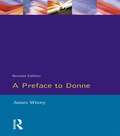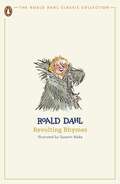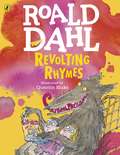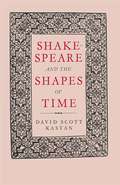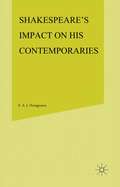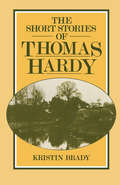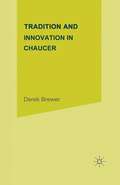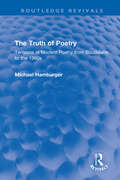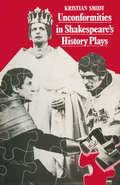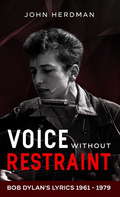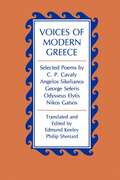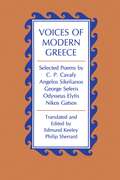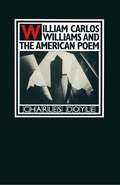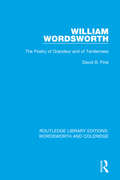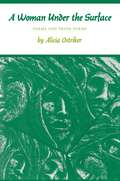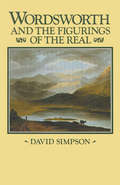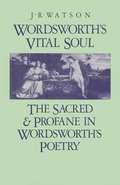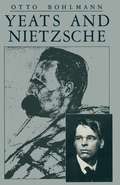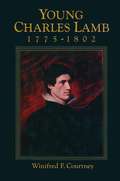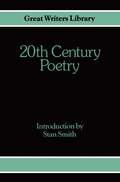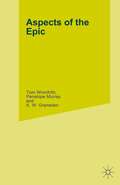- Table View
- List View
A Preface to Donne
by James WinnyProbably the most famous of the Metaphysical poets, John Donne worked with and influenced many of the leading poets of the age. This excellent introduction to his life and works sets his writing firmly in the context of his times.
A Preface to Donne
by James WinnyProbably the most famous of the Metaphysical poets, John Donne worked with and influenced many of the leading poets of the age. This excellent introduction to his life and works sets his writing firmly in the context of his times.
Revolting Rhymes (The Roald Dahl Classic Collection)
by Roald DahlAh-ha, you see, the plot grows thicker,And Cindy’s luck starts looking sicker.This beautiful edition of Revolting Rhymes, part of The Roald Dahl Classic Collection, features official archive material from the Roald Dahl Museum and is perfect for Dahl fans old and new.So, enter a world where invention and mischief can be found on every page and where magic might be at the very tips of your fingers . . .The Roald Dahl Classic Collection reinstates the versions of Dahl’s books that were published before the 2022 Puffin editions, aimed at newly independent young readers.
Revolting Rhymes (Colour Edition)
by Roald Dahl Quentin BlakeRoald Dahl's irreverent and hilarious collection, Revolting Rhymes, with splendiferous full-colour illustrations!Six of the best-loved nursery tales, retold with surprising and sometimes disgusting twists! Wicked beasts, brazen crooks and a ghastly giant star in these hilarious nursery rhymes with BITE.'A true genius . . . Roald Dahl is my hero' - David Walliams Phizz-whizzing new branding for the world's No.1 storyteller, Roald Dahl!Exciting, bold and instantly recognisable with Quentin Blake's inimitable artwork.Roald Dahl, the best-loved of children's writers, was born in Wales of Norwegian parents. His books continue to be bestsellers after his death in 1990, and total sales are now over 100 million worldwide!Quentin Blake is one of the best-known and best-loved children's illustrators. It's impossible now to think of Roald Dahl's writings without imagining Quentin Blake's illustrations.Look out for the whole collection of wondercrump Roald Dahl books!The Enormous Crocodile; Fantastic Mr Fox; The Giraffe and the Pelly and Me; The Magic finger; The Twits; The BFG; Boy: Tales of Childhood; Charlie and the Chocolate Factory; Charlie and the Great Glass Elevator; The Complete Adventures of Charlie and Mr Willy Wonka; Danny the Champion of the World; George's Marvellous Medicine; Going Solo; James and the Giant Peach; Matilda; The Witches; Dirty Beasts; The Minpins; Revolting RhymesFor Teens:The Great Automatic Grammatizator and Other Stories; Rhyme Stew; Skin and Other Stories; The Vicar of Nibbleswicke; The Wonderful Story of Henry Sugar and Six More
The Truth of Poetry: Tensions in Modern Poetry from Baudelaire to the 1960s (Routledge Revivals)
by Michael HamburgerFirst published in 1982, The Truth of Poetry attempts to answer a seemingly simple question: What kind of truth does poetry offer in modern times? Michael Hamburger’s answer to this question ranges over the last century of European and American poetry, and the result is a phenomenology of modern poetry rather than a history of appreciations of individual poets. Stressing the tensions and conflicts in and behind the work of every major poet of the period, he considers the many different possibilities open to poets since Baudelaire. This expansive work of analysis will be of interest to students of English literature, poetry enthusiasts and literary historians.
The Truth of Poetry: Tensions in Modern Poetry from Baudelaire to the 1960s (Routledge Revivals)
by Michael HamburgerFirst published in 1982, The Truth of Poetry attempts to answer a seemingly simple question: What kind of truth does poetry offer in modern times? Michael Hamburger’s answer to this question ranges over the last century of European and American poetry, and the result is a phenomenology of modern poetry rather than a history of appreciations of individual poets. Stressing the tensions and conflicts in and behind the work of every major poet of the period, he considers the many different possibilities open to poets since Baudelaire. This expansive work of analysis will be of interest to students of English literature, poetry enthusiasts and literary historians.
Voice Without Restraint: Bob Dylan's Lyrics 1961 - 1979
by John HerdmanBob Dylan was awarded the Nobel Prize in Literature in June 2016, and seldom in recent years has it been more richly deserved.That a song writer’s lyrics should be regarded as literature was an idea at which many were surprised.Others have felt that to isolate the lyrics of a song from its musical context is unreal. Ultimately that is true: a song is an indefeasible whole, an inseparable marriage of words and music which achieves its overall emotional effect by that symbiosis and not otherwise.Yet it can also be said that the two components can be separately considered as two elements in the artist’s creative utterance, and discussed as such.The evidence of Dylan’s manuscripts supports the view that in writing his lyrics his way of going about things is not always widely different from that of a poet.Bob Dylan commented on the Nobel Prize in Literature which was awarded to him "for having created new poetic expressions within the great American song tradition": "When I first received this Nobel Prize for Literature, I got to wondering exactly how my songs related to literature. I wanted to reflect on it and see where the connection was."Voice Without Restraint, refers to and is from the song “I dreamed I saw St Augustine” on John Wesley Harding, and is a phrase chosen to evoke the full-blooded commitment to his artistic utterance which is the hallmark of Bob Dylan’s voice – in all senses.
Voices of Modern Greece: Selected Poems by C.P. Cavafy, Angelos Sikelianos, George Seferis, Odysseus Elytis, Nikos Gatsos
by Edmund Keeley Philip SherrardThis anthology is composed of recently revised translations selected from the five volumes of work by major poets of modern Greece offered by Edmund Keeley and Philip Sherrard during the past two decades. The poems chosen are those that translate most successfully into English and that are also representative of the best work of the original poets. C. P. Cavafy and Angelos Sikelianos are major poets of the first half of the twentieth century. George Seferis and Odysseus Elytis, who followed them, both won the Nobel Prize in literature. Nikos Gatsos is a very popular translator, lyricist, and critic.
Voices of Modern Greece: Selected Poems by C.P. Cavafy, Angelos Sikelianos, George Seferis, Odysseus Elytis, Nikos Gatsos
by Edmund Keeley Philip SherrardThis anthology is composed of recently revised translations selected from the five volumes of work by major poets of modern Greece offered by Edmund Keeley and Philip Sherrard during the past two decades. The poems chosen are those that translate most successfully into English and that are also representative of the best work of the original poets. C. P. Cavafy and Angelos Sikelianos are major poets of the first half of the twentieth century. George Seferis and Odysseus Elytis, who followed them, both won the Nobel Prize in literature. Nikos Gatsos is a very popular translator, lyricist, and critic.
William Wordsworth: The Poetry of Grandeur and of Tenderness (RLE: Wordsworth and Coleridge)
by David B. PirieFirst published in 1982. In this study of Wordsworth’s major poetry, the author explores the conflict between the poet’s celebration of an impersonal earth and his concern for the most intensely personal relationships. The opening chapter concentrates on Wordsworth’s struggle to describe the natural world and the extraordinary claims he makes for the natural landscape — which are shown to derive not from vague mysticism but precisely articulated common sense. The close readings of Michael, The Idiot Boy, Tintern Abbey and The Ruined Cottage, and poems as passages on solitaries are supported by generous quotations and discussion of other critical views.
William Wordsworth: The Poetry of Grandeur and of Tenderness (RLE: Wordsworth and Coleridge)
by David B. PirieFirst published in 1982. In this study of Wordsworth’s major poetry, the author explores the conflict between the poet’s celebration of an impersonal earth and his concern for the most intensely personal relationships. The opening chapter concentrates on Wordsworth’s struggle to describe the natural world and the extraordinary claims he makes for the natural landscape — which are shown to derive not from vague mysticism but precisely articulated common sense. The close readings of Michael, The Idiot Boy, Tintern Abbey and The Ruined Cottage, and poems as passages on solitaries are supported by generous quotations and discussion of other critical views.
A Woman Under the Surface: Poems and Prose Poems (Princeton Series of Contemporary Poets #162)
by Alicia OstrikerFrom A Woman Under the Surface:MOON AND EARTH Alicia Ostriker ? Of one substance, of oneMatter, they have cruellyBroken apart. They never will touch Each other again. The shiningLovelier and youngerTurns away, a pitiful girl. She is completely nakedAnd it hurts. The largerMotherly one, breathlessly luminous Emerald, and blue, and whiteTraveling mists, suffersBirth and death, birth and death, and the shockOf internal heat killed by external cold.They are dancing through that blackness. They press as ifTo come closer.
A Woman Under the Surface: Poems and Prose Poems (Princeton Series of Contemporary Poets #162)
by Alicia OstrikerFrom A Woman Under the Surface:MOON AND EARTH Alicia Ostriker ? Of one substance, of oneMatter, they have cruellyBroken apart. They never will touch Each other again. The shiningLovelier and youngerTurns away, a pitiful girl. She is completely nakedAnd it hurts. The largerMotherly one, breathlessly luminous Emerald, and blue, and whiteTraveling mists, suffersBirth and death, birth and death, and the shockOf internal heat killed by external cold.They are dancing through that blackness. They press as ifTo come closer.
Wordsworth and the Figurings of the Real
by David SimpsonPerhaps the most powerful feature of the Romantic imagination is its ability to dissolve existing form and order and create it anew. The Romantic investigation of the functions of the imagination also leads to important insights concerning its problems and dangers. Because it separates the person experiencing it from others around him, the imagination introduces ways of seeing which cannot be assumed to be simply communicable or easily shared, and which have as their objects different forms or 'things'. These forms, or figures, risk becoming for their originators both vehicles of power, in so far as they do convince others of their reality, and limiting constructs of prefigured order, inhibiting their users from the perception of new relations and alternative meanings. When the figured becomes the real, there thus arise difficulties in both individual and social perceptions. Arguing from the stance that all perception takes place by a creative (and hence potentially divisive) assembly of images or qualities into things, David Simpson shows that the analysis of figurative representation in Wordsworth's writing is of central importance to his idea of the human mind, and the way in which it is affected or allowed to function by its environment, both human and physical. In this way Wordsworth's ideas about the function of literature in society are seen to be more fully worked out than readers have often assumed them to be. Simpson pays particular attention to the ethical consequences of different ways of figuring the real, offering an explanation of Wordsworth's distinction between life in the town and life among the mountains and lakes of north-west England. In relating Wordsworth's poetry to important contemporary debates in political economy such as those concerning the division of labour and the evaluation of the advantages and disadvantages of commerce and luxury, he suggests that Wordsworth is a notable precursor of that nineteenth-century tradition which sees the mind as open to critical determination by social and environmental factors.
